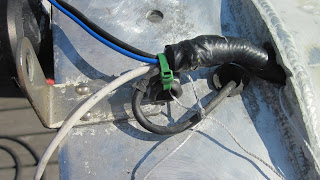Sophia took here first voyage in 2011 last Thursday. She left as a sailboat and came back as a powerboat. It was short trip - just up to the harbor crane and back.
Moving the crane in to position - about 10:30
Hooking up the strap - 11:00
Cranking the cable up the mast to the spreaders by hand - forever.
Lots of stuff happened here - took all the stays off, moved the crane over the land and lowered. Just one scary moment - the mast got hung up on the crane for moment then settled with a bang. 12:30
Taking off the spreaders - 1:00
It took us another hour to move the mast on a wheeled dolly around the boats in this photos, swing one end over another person power boat (glad he was not there at the time, he might of been nervous), then move a guys bike, displace a women working at one of the picnic tables and roll the mast down the dock to a couple of free mast stands. All told it took us 4 hours from leaving the dock to back to the dock. whooo!
So, why did we take the mast down? Primarily it was for maintenance and also to add some wiring for a new steaming/deck light and new VHF antenna. But once it's down, there's lots to be done.
Karl sanding. Ohh ahh! We first planned to repaint the mast, but since decided to take the paint off and leave the bare aluminum. It is better for the aluminum and less maintenance in the future. Unfortunately it meant a lot more sanding. If the photos were proportionate to the time it took, you'd be looking at a lot of sanding photos.
This is the conduit inside the mast for the wires. There were some old wires, which had been cut off at some earlier point inside the conduit, and very securely attached such that we couldn't pull them out. We had to drill out the rivets holding the conduit in order to remove the old wire. We then reattached the conduit, which is not an easy process...
Every few feet was a set of rivet holes. One for affixing the conduit and the other "helper" hole to hold the conduit in place.
Once the "holding" rivet was in place we'd fill the other "helper" hole with another rivet, just so it looks nice.
After the end of a long day, nothing makes Karl happier than tidying up. Actually he's been pining over a small wet/dry vacuum for the boat. We happened to see a 12-volt version earlier in the day so we can use it on the boat. See how happy he is!
Rachel got "Tom Sawyered" into finishing sanding the mast. Never had a better time in her life!
This is the wiring job for the masthead lights, antenna, and wind instrument. There's a protective hose to prevent chafe and the zip tie helps take the weight of 60 feet of wire so it isn't hanging on the connections. Also, another messenger line for future use if we need to run a new wire up the mast.
We restepped the mast on Monday night, after 5 days of work, finishing up just at dark (10:00pm). Here's what it looked like...
At the staging area doing all the final preparations before lift off...
I sure hope this thing holds! Here's the mast precariously perched part way above land and part way over Sophia.
And what it looks like on the Sophia end of things. Karl controlled the mast base with line.
The restepping went fairly smoothly. The forestay was a bit of bugger to attach, but with a quick pulley system we were able to get it tight enough to get the pin in. Then, just as we were finished the crane strap got caught and while we had a retrieval line tied to it, we couldn't get it clear of the track on the front of the mast. A quick tape job between the pole hook and a piece of pipe did the job, and we were able to get free of the crane.






























































